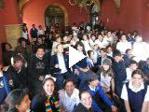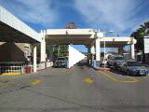In Loreto, I discovered the firehouses. Firemen often have extra beds at their stations, and seem to be very friendly to gringos biking and talking about climate change. I stayed with the friendly bomberos (Spanish for firemen) in Loreto before heading south, following the road first along the shore and then southwest across Baja.
Southwestern Baja is a large coastal plain, where a number of crops are grown by pumping water from deep underground. Fields of corn grow strangely next to fields of cacti.
Stopping at a gas station, I met Rafael, who owned both the store and a small herd of goats. In exchange for a short English lesson, Rafael let me watch while he killed and gutted a young goat. I think Rafael got the better end of the deal.
I stayed with the firemen in Ciudad de Constitución, where I watched a Jakie Chang movie dubbed in Spanish. I then rode two days back southeast across the peninsula to La Paz, the largest city in southern Baja.
At the suggestion of a local, upon arriving to town, I went to the local news. In less than an hour, without a shower, I was live on television, answering questions about bicycling and climate change.
I am in La Paz now, where I will be for a few days trying to hitch a ride on one of the yachts sailing for the mainland. I am staying in the extra bunks with the generous and extremely friendly local firemen. The fireman sleep downstairs because, as they say, the upstairs is haunted by their former chief, who passed away 4 months ago. After saying words of appreciation for the generosity of firemen, I have slept comfortably upstairs, by myself.






